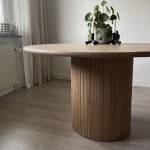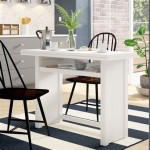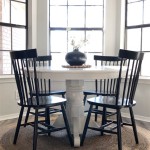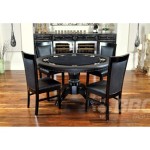The Versatility and Functionality of Large Round Dining Tables with Extension Capabilities
The dining table serves as a central gathering point in many homes, facilitating meals, conversations, and shared experiences. Selecting the right dining table involves careful consideration of size, shape, material, and functionality. Large round dining tables, particularly those with extension capabilities, offer a compelling option for homeowners seeking both style and adaptability.
The circular shape of a round dining table promotes inclusivity and encourages conversation among diners. The absence of corners fosters a more egalitarian setting, making it easier for everyone to see and interact with each other. When combined with an extension mechanism, a large round dining table provides the flexibility to accommodate both intimate gatherings and larger dinner parties.
Space Optimization and Adaptability
One of the primary advantages of a large round dining table with an extension feature lies in its ability to optimize space. In its round configuration, the table occupies a relatively compact footprint, making it suitable for smaller dining rooms or open-concept living areas. However, when the need arises, the table can be expanded to accommodate additional guests, effectively transforming a cozy dining space into a more formal setting. This adaptability is particularly valuable for individuals who frequently entertain or host family gatherings but do not want a permanently oversized table taking up valuable space.
The extension mechanism itself can vary depending on the table's design and manufacturer. Common types include leaves that are stored internally within the table's base, butterfly leaves that fold out from under the tabletop, and separate leaves that are stored externally and inserted when needed. The ease of use and storage of the extension mechanism are important factors to consider when selecting a large round dining table. Tables with self-storing leaves offer the most convenience, as they eliminate the need to find a separate storage space for the extended portion.
Furthermore, the extended leaves are typically designed to seamlessly integrate with the existing tabletop, maintaining a consistent aesthetic and preventing visual disruptions. This ensures that the table looks elegant and cohesive, whether in its round or extended configuration. The transition from round to oval or oblong shape, depending on the extension leaf design, should be smooth and unobtrusive.
Aesthetic Appeal and Design Considerations
Beyond its functional benefits, a large round dining table with an extension feature can also enhance the aesthetic appeal of a dining space. The circular shape lends itself to a variety of design styles, from traditional to contemporary. The table can serve as a focal point, drawing the eye and creating a sense of visual interest. The choice of materials, such as wood, glass, or metal, further contributes to the table's overall aesthetic.
Wooden dining tables offer a classic and timeless look, providing warmth and character to the dining room. Different types of wood, such as oak, maple, walnut, and cherry, offer varying degrees of durability, grain patterns, and color variations. Consider the existing furniture and décor in the dining room when selecting the type of wood for the table. A lighter wood, such as maple, might be ideal for a Scandinavian-inspired space, while a darker wood, such as walnut, might be better suited for a more traditional setting.
Glass-topped dining tables offer a more contemporary and minimalist aesthetic. The transparent surface creates a sense of spaciousness and allows the base of the table to be more visible. Glass tables are easy to clean and maintain, making them a practical choice for busy households. However, they may not provide the same level of warmth and character as wooden tables. Furthermore, glass surfaces tend to show fingerprints and smudges more readily.
Metal dining tables, particularly those with sleek and modern designs, can add a touch of industrial chic to a dining space. Metal tables are durable and resistant to scratches and stains. They can also be powder-coated in a variety of colors to match the existing décor. However, metal tables may feel colder and less inviting than wooden tables. The design of the base is especially crucial for metal tables to ensure they are both aesthetically pleasing and structurally sound.
The size of the table, even when extended, also warrants careful consideration. Too large a table can overwhelm a small dining room, while too small a table may not adequately accommodate the intended number of guests. As a general guideline, allow at least 24 inches of space per diner to ensure comfortable seating and movement around the table. Measure the dimensions of the dining room and plan the table's placement accordingly, accounting for chairs and other furniture.
The Social Dynamics of Round Table Dining
The round shape of the table encourages a more inclusive and interactive dining experience. In a rectangular or square table setting, certain individuals may be positioned at the head or foot of the table, creating a sense of hierarchy. A round table eliminates this hierarchy, promoting a more egalitarian and collaborative atmosphere. Everyone at the table has equal visibility and can easily participate in the conversation.
This is especially beneficial for families with children, as it allows parents to maintain eye contact and engage with all of their children more easily. It also fosters a sense of unity and connection during mealtimes. For social gatherings, the round table encourages more informal and relaxed interactions, making it easier for guests to mingle and converse with each other.
The ability to extend the table further enhances this social dynamic. When additional guests arrive, the table can be expanded to accommodate them without compromising the sense of intimacy and connection. The extended leaves seamlessly integrate with the existing tabletop, ensuring that everyone feels included in the conversation and camaraderie. This adaptability is particularly valuable for individuals who enjoy hosting large dinner parties or holiday gatherings.
Furthermore, the round table configuration can facilitate better communication and understanding among diners. The ability to see everyone's facial expressions and body language can enhance nonverbal communication and foster a stronger sense of empathy. This is especially important for conflict resolution and problem-solving, as it allows individuals to better understand each other's perspectives. The absence of corners also contributes to a more relaxed and comfortable atmosphere, reducing the likelihood of tension or awkwardness.
In summary, a large round dining table with an extension feature offers a compelling combination of space optimization, aesthetic appeal, and social benefits. Its adaptability makes it a versatile choice for homeowners who value both style and functionality. Careful consideration of the table's size, material, extension mechanism, and design aesthetic will ensure that it seamlessly integrates into the dining space and enhances the dining experience.

Biground Extendable Round Dining Table

Woods Perth 135 185 Round Extending Dining Table Furniture

Brooklyn Round Extending Dining Table Fairway Furniture

Vancouver Round Extending Dining Table Brentham Furniture

Fairfax Reclaimed Slatted Wood 135cm 185cm Extending Round Dining Table Furniture World
Round Dining Tables Furniture Village

Big Round Transformable Dining Table London Bonbon Compact Living

Extendable Round Dining Table Devereaux In Echo Oak 122 162cm

Extra Chunky Extending Round Rustic Dining Table

Conrad Extension Dining Table Herringbone Detail








